Dynasties 3-5 2649 - 2134 BC (515 years)
The Age of the Pyramids
By Ottar Vendel
Dynasty 3
2649 - 2575 BC
more than one candidate to be the founder. The table of Nabil Swelim below
is based on the opinion that the complex of Djoser was a cultural peak
that had developed for a period of about 60-80 years of the dynasty.
There is no general agreement among scholars on this table.
Khaba and Sa are usually put at the end of the dynasty
topped by Sanakht followed by his brother Djoser.
This era is famous for a new type of tomb
which gave Egypt fame through
of all times - the great
Pyramids.
(after Nabil Swelim 1993)
| Name (HORUS, others) | Egyptian lists | Manetho (Africanus) | Years Swelim |
Years Man. | |
| 1 | KHABA, Nebka, Hornub, Iretdjetef | Nebka | Necheropes | 19 | 28 |
| 2 | SA, Sadjeser, Djeser | Djeser, -sa | Tosorthros | 19 | 29 |
| 3 | BA, Teti | Teti | Tyreis | 7 | 7 |
| 4 | SANAKHT, Yjehnwneb | - | Mesochris | 17 | 17 |
| 5 | NETJERYKHET, Bity Sensen | - (Djoser) | Soyphis | 30 | 16 |
| 6 | SEKHEMKHET Djesertyankh | Djeser -teti -ty | Tosortasis | 16 | 19 |
| 7 | ?, Nebtawi Nebkare | Nebkare | Akhes | 3,5 | 42 |
| 8 | QAHEDJET, Nebnubhedjet | Neferka, -re | Sephuris | 2,5 | 30 |
| 9 | ?, Huni | Huni | Kerpheris | 24 | 26 |
| Total years = | 138 | 203 |
At the temple of Seti I at Abydos (19th dynasty) five cartouches below hold the names of the pharaohs from the third dynasty. The Turin canon (on papyrus) made half a century later has also five names: Nebka, Djoser, Djosertety, (unknown name) and Huni.
Over 1.000 years had passed since dynasty 3 and minor rulers were probably excluded and the positions and lengths of reigns for the others were probably uncertain.
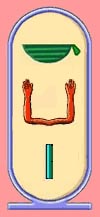 Nebka |
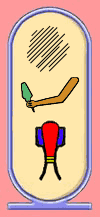 Sa Djeser |
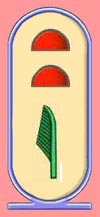 Tety |
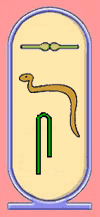 Sedjes |
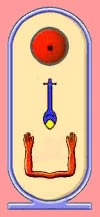 Neferkare |
The correct position of this pharaoh is probably at the end of the dynasty and likely where the Turin Canon has the entry "Hudjefa" (see menu left). Though the name Khaba appears in second position (with a reign of 19 years) it is likely that the knowledge about him was wage when the list was made more than a thousands years after his death.
He is attested for through archaeology at only four places where his name comes forward twelve times. These locations are Abusir (see illustration below) and Nagada plus Hierakonpolis and Elephantine (Aswan) where two sealings with his name have been found.
Practically nothing is known about him with one great exception - a pyramid at Zawiyet-el-Aryan 7 kilometers north of Sakkara.
Though his name has not been found in the monument itself it is thought to be his last resting place and it's generally referred to as the Layer Pyramid because it was built of thick leaning accretions with sloping courses of stone, a technique modified and improved at the beginning of the next dynasty. His name has been found inscribed on eight stone vessels found in a mastaba tomb a bit to the north. The pyramid itself has given no written remains at all, at least from the time it was built.
The king probably died before the finishing of his monument and the work on the site was abandoned for all future.
The construction is a square with a 78,5 m long side at the base, and placed on the highest part of the area overlooking the cultivated Nile valley. With only 200 metres to the flood plain in the valley it's the pyramid in Egypt that is placed nearest the cultivated land.
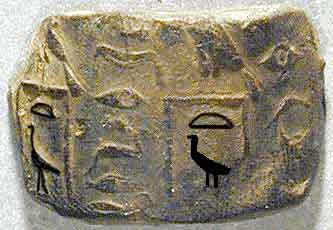 |
Small relief with Khaba's name twice (blackened). His name also occurs at a 5th dynasty pyramid and in tombs by his pyramid at Zawiyet el- Aryan. |
With the intended five steps it would have been about 45 meters in height if it had been completed but today only 17 meters remain above the sand.
Under ground huge galleries (very similar looking those from the pyramid of Sekhemkhet) were hewn out but the burial chamber did not contain anything, not even a sarcophagus, when it was entered in the late 1800s.
Facts that indicate that it was built in the middle or at the end of the dynasty is the increasing ability of the Egyptians to manage to handle larger and larger stones, culminating during the end of the Old Kingdom. Khaba's monument is built with stones of bigger size (for the pyramid's core) than Djoser's, indicating it's younger. The construction has also an almost perfect orientation North-South that most older monuments (including substructures) don't have.
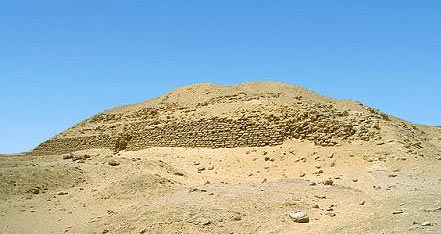 |
| How the Layer Pyramid of Khaba looks today from the north side. Visible at the base (left in picture) is where the trench is going in. |
If king Khaba is the regent historian Manetho calls Necheropes he is by tradition in the second century BC said to have been in office for 28 years. This seems to be too long considering how much (or little) have been finished of his monument.
If on the other hand he is the ruler referred to in Egyptian lists as Nebka, archaeological remains have made an estimation of 3 to 5 years on the throne as more likely. In the Royal Canon of Turin the name of the ruler noted before Huni is erased, but a reign of six years is readable.
It's disputable to put Khaba as the founder of the third dynasty and the reigns of his and Sekhemkhet's were brief ones and generally estimated to be after king Djoser's.
The traditional sequence of kings for the dynasty still is among most Egyptologists: Sahnakht-Djoser-Sekhemkhet-Khaba-Huni added with those who are only known from names in king lists or fragments and have left no monuments to history.
This obscure king is another example of the scanty remains that history has provided us with from parts of the third dynasty. If he was a separate king or just another name of someone better known we don't know for sure but a strong indication is that he is identical to a Djoser (not the king with the Step Pyramid) which in the Abydos list has the addition "za" to his name. His sereks contain a single bird facing right and this is a sign also seen from a king (simply called Bird) believed to have ruled for a short time during one of the dynasties prior to the third. Swelim puts king Sa as the second in the dynasty and gives him the other names Sadjeser and Djeser and identifies him with the ruler named Tosorthos from the list of Manetho (Africanus) or Sesorthos (by Eusebius). This may be correct, but far from all Egyptologists (probably not even a majority) will agree on this.
One of three names inscribed on stone vessels from galleries under ground in Sakkara. A falcon facing right and a sa-sign below. |
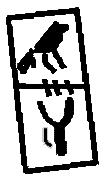 |
For a ruler being on the throne for 19 years (according to Swelim) remarkably little is left of his deeds as monuments and inscriptions are concerned. All remains are three sereks with is name marked on stone vessels found in the galleries under the step pyramid of King Djoser.
When looking at these one thing is striking - the identification of the king - the Horus falcon, is put within the serek and not outside on top as all the other rulers had done in the past. This design did not appear again from any king in the future and can be an indication that this is secondary name (Sa) for another ruler better known. Candidates of some Egyptologists are king Ba (below) and Bird (see this king in table of dynasty 1) whose position is very uncertain and has been put in late dynasty 1 or in dynasty 2. In his book "Some problems on the history of the third dynasty" from 1983 page 224, Swelim suggest in a table that the tomb of pharaoh Sa might be found within the enclosure Gisr el Mudir at Sakkara. After some investigations the past years (up to 2007) nothing has been found to support this theory.
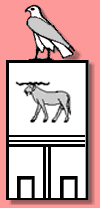 Nobody knows for sure to which dynasty this obscure king belongs. His sereks were found
already in the first half of the 1800s, but during the end of the 1900s scholars have taken up
the question about when he had his reign.
Nobody knows for sure to which dynasty this obscure king belongs. His sereks were found
already in the first half of the 1800s, but during the end of the 1900s scholars have taken up
the question about when he had his reign. There is a lack of agreement in this question and Egyptologists' opinions are divided spanning between the later half of the second dynasty to the end of the third. In the second case he might fit in to a period not so well known, where historian Manetho has more names on his list than archaeology has been able to provide so far.
The three known signs building up his Horus-name (within a serek) has a human leg in two cases and one of them (picture left) has no Horus falcon atop. The third inscription has an additional sign of a ram
 and this has confused some Egyptologists and it's not quite sure that it's an icon of the same pharaoh.
and this has confused some Egyptologists and it's not quite sure that it's an icon of the same pharaoh. The human leg stands for the letter (and sound value) B and the name of a ram is pronounced BA making it - BBA a confusing row of letters (possibly read Beba or Baba?). Some scholars identify this ruler with king Bird due to the fact that the hieroglyphs have more or less the same sound value. A majority of Egyptologists agree upon that he probably is to be put in during the third dynasty, likely at the end with a brief period in office. Nabil Swelim and Peter Kaplony take another view and put him in the first half of the period. Like in the case of pharao Sa above, Swelim has suggested a place for his tomb and has chosen the so called "Ptahhotep enclosure" in Sakkara. Nothing has been found (up to 2007) which can verify this theory. (See the table of Swelim at top at the start of dynasty 3).
This pharaoh has been considered to be the founder of the third dynasty, but in the last decades of the 1900s this has been questioned by Egyptologists. A fact is that Sanakht's tomb isn't found with certainty, but the big mastaba from Beit Kallahf near Abydos (see picture below), has very strong indicators to pointing out his final resting place. Since historian Manetho has stated that a ruler from this time was very tall and heavy built, the earthly remains from this mastaba-tomb makes it even more spectacular since it might be the oldest pharaoh preserved from this early state of Egyptian history.
His stature (25 cm taller than an average Egyptian at the time) might tell that he had a light syndrome where an extra growth to the body is marked by expansion of the lower jaw-bone. His younger brother(?) Djoser was a heavy built too, but not so tall.
| Skull from a big ruler (1.86 m) found in 1902 in the grave chamber (red) of a brick mastaba at Beit Khallaf. It might be the remains of king Sanakht whose name was found on many seals etc. The never used additional tomb (right) can if so, be the one of his first queen. | 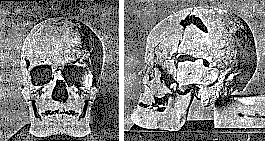 |
 |
|
| The 50 m long mastaba (light blue) was enlarged a bit with another (yellow). The skeleton remains were found in the chamber (red) and big stone stoppers (green) blocked the passage for robbers, to the owner's final resting place. | |
The mastaba at Beit Khallaf is almost untouched since 1902 when it was investigated. What is left above ground today can be seen here in a couple of photos taken from a visit there in December 2006.
Almost nothing is known of his reign and in the king lists he occurs as in the list of Manetho as Mesochris with a length of reign of seventeen years according to Swelim's list. Most other Egyptologists agree on that he is the king called Nebka (Khaba) and that follows the tradition that he was an elder brother of king Djoser.
The Egyptian lists give no indication of him, at least with a name that can be interpreted as him.
Among the very few remains of him are fragments from two depictions in stone found at the Sinai peninsula, telling that there was active mining there during his reign. These are the only(?) two depictions known of him up to now (April 2002).
Some fragments with his name have been recovered from various places like Sakkara and Aswan, and a mud brick structure at Abw Rawash north of Giza has been connected to him on stylistic third dynasty grounds as a suggestion. Today only fragments are left of what seems to have been a quite large enclosed area (330x170m) with a 20 m square pyramid like massive structure in the center. This place has been suggested by Nabil Swelim (1984) to be his tomb, but no names or objects pointing towards the king have been found in the vicinity though.
A Sakkara tomb from a fourth dynasty official has left remains telling that the owner once had been working for the death cult of Sanakht, indicating that his memory was venerated in a mortuary shrine in that area long after his death.
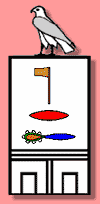 Djoser (Netjerykhet) actually meaning "King Ykhet" since Netjer was the Egyptian word for king, and written as hieroglyphic sign: a flag on a pole, as seen inside his serek to the right.
Djoser (Netjerykhet) actually meaning "King Ykhet" since Netjer was the Egyptian word for king, and written as hieroglyphic sign: a flag on a pole, as seen inside his serek to the right.
He is one of the most outstanding rulers in the whole Egyptian and human history. The remains from his reign is of such a dignity that it turns a new chapter in the developing of mankind since the invention of writing half a century earlier.
He was the first king to have the combination: supreme power - long reign, talent to pick officials to organize the manpower and use the skills of the whole Egyptian people.
One of these officials was a man by the name of Imhotep (see him on Gods' list). He was of unknown origin and is of some scientists today considered to be the king's son though he was never mentioned as a prince. Under his supervision was made a gigantic enclosed area with a building in great size made of hewn stone for the first time in history. It was the great tomb of his master, the Step Pyramid, that he erected at the cemetery area of the capital Memphis. Today it's known as the mortuary complex at Sakkara (see below) and is still standing to a great extant and partly reconstructed. The monument has gone through many changes during its erection from being a quite modest mastaba at the beginning. The substructure has lots of chambers where finds from older kings as well have been found. It was obviously gathered here by orders from the king himself, possibly to prevent robbers from scattering the remains of his forefathers.
In a secondary tomb in the southern part of the area (# 5 in picture below) was found glazed green tiles as decoration of the walls. This was probably a tomb to contain the king's intestines, lungs and liver. In Septenber 2021 the Egyptian government made the tomb accessable to the public after a renovation time of arounf fifteen years.
| King Djoser's Complex at Sakkara |
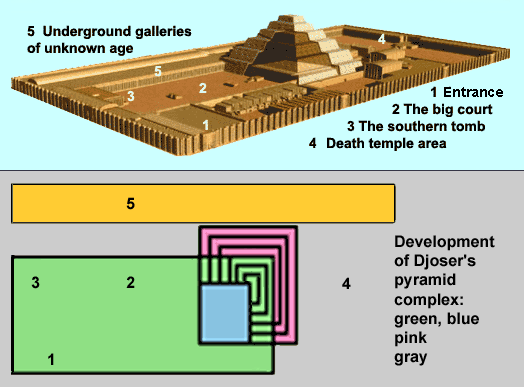
|
The area was originally intended to be smaller (green) with a single mastaba tomb (blue). It was extended to 530 by
The entrance hall was roofed with stone supported by pillars halfway built into the walls. To the right was a row of small buildings for ceremonial purposes and a stand for the canopy over the royal throne. The almost 400 meters long underground galleries (5) are of older date and the owner is unknown. They were probably built by a king during the dusky second dynasty. This burial ground for the royal family and nobility of the capital Memphis should be the prime cemetery for the next 2.500 years to come.
Most of the structures were unique and had no precedent in Egypt or elsewhere in the world at the time with its vast quantity of architectural innovations.
Stone cutting as such was by no means new to the Egyptians who had made huge tunneling jobs and walls earlier (see king Khasekhemwy of dynasty two), but making buildings in stone in such dimensions had never been made before. Chief architects, prime minister, pharaoh's physician and poet were among the many skills and titles of the genius behind this - Imhotep. Later in history he was the only human to be taken up among the gods in Egypt and he was venerated for thousands of years into the Roman era 2,5 millennia after his death. Stone scul- pturing and pillars imitating flowers from nature were among his inventions that the world now saw for the first time.
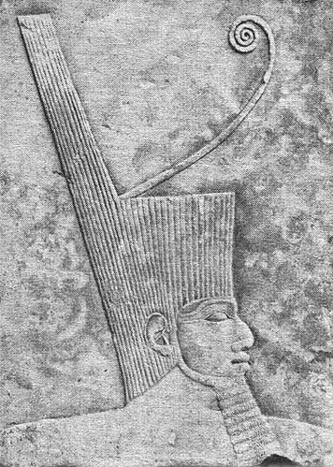
| 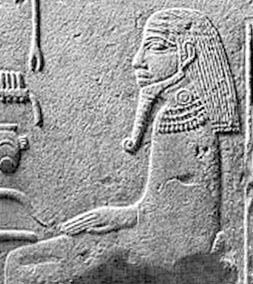
|
|
Two reliefs of the great pharaoh Djoser presenting him in impressive poses. At left it clearly shows his broad and heavy looks like his supposed brother Sanakht above. To the right he is sitting wearing a broad necklace and a long wig in the fashion of a priest. The artist has added an unique feature to a king though. Besides wearing his traditional false beard, here he seems to have a moustache or is it just his broad lips? |
Besides the step pyramid another monumental building was built during Djoser's reign. It is a mastaba tomb at Beit Khallaf in Middle Upper Egypt, called K1 and made of sun dried mud-bricks. This spectacular monument is presented on this site in a big picture report from photos taken during an investigation of the monument made by the author Ottar Vendel, on Saturday the 9th of December, 2006. No investigation has been made and hardly any photographs have been taken here in the last hundred years, but now over twenty fresh ones can be seen in the exclusive Beit Khallaf Photo Odyssey 2006.
Its huge size makes it outstanding in Egyptian brick architecture. It was the last great tomb erected in the south before going into the era of monumental buildings of stone in the north.
Very close is the mastaba K2 made during the reign of Sanakht shown and mentioned above and in the vicinity is the abandoned old capital of This (Tinis), which possibly is today's Girga. As to foreign politics Djoser was concerned about protecting his country from outsiders and he took a firm grip of the southern province Nubia, permanently making it the outpost to black Africa upstream.
One of the reasons that made the country flourish under his rule was the fact that no actual threat from outside seems to have been at hand. Thus during this period of peace the enormous progress in practically all sectors of society were made.
His name Djoser first appears many hundreds of years after his death, in a New Kingdom stone stele on the island of Elefantine at Aswan. In his own time he was always referred to as (Horus) Netjerykhet on all monuments and inscriptions. From Djoser's reign and onwards the capital Memphis was the center of the united country and the links to the old royal cemetery at Abydos in Upper Egypt were cut permanently. After his death there seem to have been some disorder in the sense that no heir of his could take over the throne, as far as is known today (2002). It is possible that sons (or sons-in-law) of his, took over, and if so they are presented below.
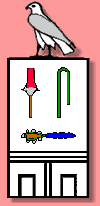 King Sekhemket appears in the Turin Canon under the name of Djoser-Ti right after Djoser and in front of an erased entry. His age is not present but the length of his reign is - 6 years. He was totally unknown until 1951 when his monument was excavated at Sakkara, and after that few new remains of his have been found, the most recent a seal impression from the remote southern fortified island of Elefantine i Aswan, published in 2005.
King Sekhemket appears in the Turin Canon under the name of Djoser-Ti right after Djoser and in front of an erased entry. His age is not present but the length of his reign is - 6 years. He was totally unknown until 1951 when his monument was excavated at Sakkara, and after that few new remains of his have been found, the most recent a seal impression from the remote southern fortified island of Elefantine i Aswan, published in 2005.By looking at photographs taken from the air archaeologists knew that a long rectangular area was situated just a couple of hundred meters south west of Djoser's complex. This turned out to be the remains of the now called "Buried Pyramid". The name is from the title of the book written by the chief archaeologist who dug it out in the early 1950s. Unfortunately he died before he had publish a full report of his work.
The pyramid was once intended to be enclosed by a wall, but the whole was abandoned after a few years of work, obviously because the owner had premature death.
The first one and a half steps were still in place when it was found, and it had a height of eight meters. Probably it had been twice as high before the work was stopped, and the site had later been a stone quarry for building material.
The base side was 132 meters and the final height would have been about 70 m, making the monument larger than Djoser's.
Lots of work had been done to level the topography by a pattern of thick walls in squares filled with debris. Under ground in the bedrock was a long corridor on three sides of the pyramid, from which 132 store rooms were connected and exactly under the center was the king's burial chamber, which held a small sensation.
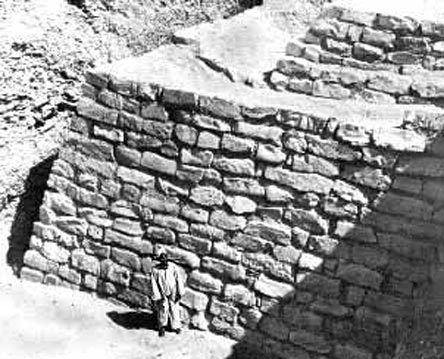 |
| The south-west corner of Sekhemkhet's pyramid as found in 1953. |
On the way down into the inner constructions in the bedrock under the monument the floor in the corridor (made of soft clay that had been brought there) revealed a first class treasure. There were hundreds of stone bowls, many of them deliberately smashed, and above all - a group of 20 golden bracelets and armlets plus a little gold box made in form of a seashell. This is still (year 2002) the oldest finds of golden jewelry of its kind, from dynasty three and older, found in Egypt.
In a couple of places on the way down masonry blocked the passage and it was clearly shown that the original work had been broken up and remade.
Inscriptions on a group of bowls gave the name of the owner - a until then unknown king called Sekhemkhet, a name never seen before, and it was puzzling to science. When another name - Djeserty, came up, the king could be identified from the list of Manetho as the successor of pharaoh Djoser (see Swelim's table).
Now Egyptologists could reinterpret a stone relief from Wadi Maghara, a mining area in Sinai, as a remnant from Sekhemkhet. He is seen in the traditional poses striding wearing the two crowns of Egypt and slaying enemies with a mace.
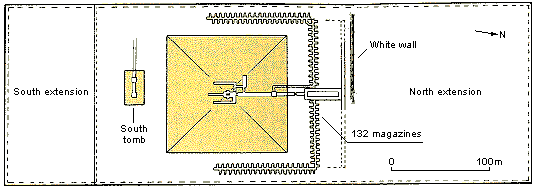 |
| Sekhemkhet's complex was intended to be 518 by 183 metres and the "white wall" made of lime stone masonry in recesses should have enclosed the whole area. |
When the grave chamber was reached a sensation waited - a sarcophagus made of white half transparent alabaster and without a lid on top. Instead it had sliding panel at one of the gavels.
It had been repaired from wounds made by bits of rocks falling from the ceiling in the crude hewn room that contained nothing else but this big coffin plus fragments of wood placed on it in a circular form, first thought to be flowers. The entry through the sliding panel was sealed wit gypsum and the expectations were high to find the mummy of the king inside.
When the sliding panel was lifted in 1954 with the world press and prominent guest present, the stone coffin turned out to be totally empty. A good guess is that the tomb had been robbed a long time ago and the mummy and the offerings taken away. The burial place had thereafter been repaired in later times (probably during the New Kingdom) like other old monuments.
By the south side of the pyramid was placed a minor so-called "south tomb" (see picture above), with remains of a mastaba construction above ground measuring circa 15x30 meters. The substructure was - like the one of the pyramid, not finished. It was a single shaft with a chamber 30 m below the surface. When entered in 1967 it contained nothing but the remains of a wooden coffin and the skeleton of a young boy of about 2-3 years of age. This can possibly be a son of the king but nothing is sure about Sekhemkhet and his brief reign. Stone vases and gold leaf fragments from jewelry were also found in this obviously looted tomb.
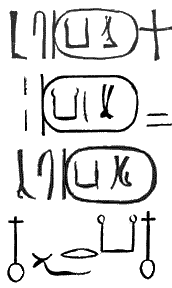 Archaeologist Swelim proposes that Nebkara was the IIIrd Dynasty king who began the huge
Unfinished Pyramid of Zawyiet el Aryan. On a dozen pieces of wood and ivory names in hieratic
writing within the cartouches have been found (picture right). They have been proposed to be
read as Nefer-ka, Neb-ka plus half a dozen more including Ba-ka and Bik-ka which was a king probably from dynasty 4 (see him).
Archaeologist Swelim proposes that Nebkara was the IIIrd Dynasty king who began the huge
Unfinished Pyramid of Zawyiet el Aryan. On a dozen pieces of wood and ivory names in hieratic
writing within the cartouches have been found (picture right). They have been proposed to be
read as Nefer-ka, Neb-ka plus half a dozen more including Ba-ka and Bik-ka which was a king probably from dynasty 4 (see him).Some scholars think he is identical to Neferkare below which shows the lack of agreement (and finds) regarding this period. The only signs readable for sure is the one without a royal cartouche (bottom) is Nefer-ka, and it's not sure that this name means the same king as the signs within the typical royal oval that are unique (beside the clearly ka-sign) and have only been found at this site.
Swelim points out that bones found by the archaeologist Wain- wright in the burial chamber of the very large Mastaba #17 at Meidum (in map at king Huni below), could be those of Nebkare.
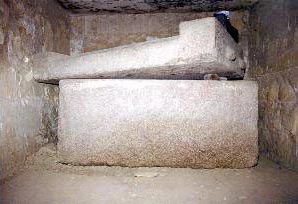 |
| Mastaba 17 at Meidum contains one of the oldest royal sarcophaguses in Egypt. Under the lid of the pink granite coffin someone (the robbers?) have left a mal- let. King Nebkare has been suggested as the owner of this big mastaba tomb. |
The find was rare because the body appeared to have been defleshed and the eyes torn out and replaced by paste balls. The limbs (including the penis) had been cut off(?) and wrapped in bandages separately. Wooden models of the royal insignia (mace and crook) were also found in the chamber (Wainwright: Meidum p. 13 ff and plate XI). The scenario looks like a restoration after damage made by grave robbers, and the royal insignia is a remarkable piece of evidence that indicates a burial of a king.
The fact that the big sarcophagus still is in place is due to the fact that it was built into the grave chamber during the erection of the tomb and impossible to remove without making a huge tunnel from outside.
This pharaoh was unknown to Egyptologists as depicted by the name of Qa-Hedjet until the late 1960s when a stele came forward after being hidden for 5.600 years. Instead of hieroglyphs within the serek with his Horus-name, this pharaoh had a picture of the white royal crown of Upper Egypt - the Hedjet, (picture below right).
He is embraced by the god Horus, the incarnation of the king's person.
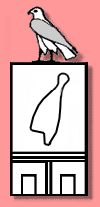 The unusual name can be some sort of expression from the monarch that he descended from that
part of the country. In 1983 Swelim "identified" him with king Huni.
The unusual name can be some sort of expression from the monarch that he descended from that
part of the country. In 1983 Swelim "identified" him with king Huni. By the artistic style scientists could place the stele as being a work from time of the third dynasty and today most of Egyptologists think that this is the Horus- name of pharaoh Neferka(-re) known from several king lists.
The three parts Nefer (beautiful), Ka (soul) and Re (the solar god) were very common at the time and so were Nub (gold) and Neb. When these parts plus the name of the crown showed up in writing as "Nebnubhedjet" it could be recognized as probably another form of the name due to the unique crown.
As for the earthly remains from this ruler, the pages in the history books are blank, or maybe dusky.
No building has yet been classified as his with certainty. Swelim has stated that Neferka "seems to have completed the burial chamber of Mastaba 17 at Meidum for the reburial of Nebkare and filled the trench and pit of the Unfinished Pyramid in the style of architecture that would have pleased Nebkare". (See text on Nebkare above and picture at Snofru below).
Looking at the brief reign he had, (Manetho's 30 years seems incorrect), it's quite possible that someone else overtook the grave he probably had started to build for himself wherever it was located. Egyptologists still are waiting to find something of substance left from his reign and for the time being he's a ruler known only from his name written in later times. But the magnificent stele of his so recently discovered (on the antiques market) hopefully points to the fact that there still are remains of him to be revealed from this period not so well known. His tomb has not been found.
the lost pharaohs
When the Royal Canon of Turin was made during the 1200s BC, a couple of names in the origi- nal list that it was copied from were illegible.
To mark this fact the working scribe wrote "hudjefa" (erased) inside the cartouche.
Egyptologists in the early times wrongly took it for a name of a pharaoh.
The entries give the kings' so called "newsy-bity" name starting with the title: "He of the sedge and the bee". These were the symbols of Upper and Lower Egypt and the title thus means "king over the two countries".
 Second last king of dynasty 2. |
 Second last king of dynasty 3. |
Next is the cartouche with the king's name, and a seated falcon marking the end of the name. Then it's a crooked stick for "time" and the circle and half-circle for "rule", followed by the years of his reign in years and months. The figures after the second black point tell the age of the king when he died.
In the second entry most of the hudjefa mark is unreadable, but the two birds tell what was inscribed. Thus we have two anonymous kings and some facts about them. The one from dynasty two might be king Khaba (see him) who started a pyramid at Zawiyet el Aryan. Here he is put in dynasty two instead of three.
The one from dynasty three can possibly be one of two named Akhes and Sephuris by Manetho. At least the position and duration of their reign according to Swelim (table at top of the page) are rather well fitting.
1) Second last king of dynasty 2: reign - 8 years and 4 months, age: 34 years.
2) Second last king of dynasty 3: reign - 6 years. The rest of the entry is lost.
The Sakkara list is from a private tomb made during the same era. It has just one hudjefa-notation like the one from the second dynasty above. It's written in the same position replacing the lost name of an unknown ruler who died in his early thirties.
It is quite possible that we today know his name without knowing that he should be placed where a Hudjefa sign was put. Some of the single or rarely occurring names of kings found from the dusky second dynasty period might be his.
Huni was the last Egyptian King of the 3rd Dynasty. His Horus-name, usually written within a serek, is not known, and unfortunately not so much of his deeds are known despite the fact that he obviously had a reign of about a quarter of a century. His name is present at the royal canons of Sakkara and Turin, but not in the Abydos-list. An inscription with the name Nswth or Nswth Hun(i) is known from Aswan in Upper Egypt. Another form of the name - Swtenh, Nisuteh or Nswt H(w), is carved on the Palermo Stone by fifth dynasty king Neuserre, who dedicated a monument to him.
Not a single depiction of him in stone or on papyrus has survived, and no sculpture can be connected to him with certainty.
A red granite head of a king wearing the crown of Upper Egypt has by some been said to be a portrait of him, but this is pure speculation. A look at the looks of the face in it rather gives it a similarity to Snofru and his son Khufu with their fleshy cheeks. It's today to be seen at the Brooklyn Museum in New York.
Huni's great monument has a characteristic silhouette at the horizon. The inner core of three steps is what remains and practically all the white lime stones from the casing are gone. The debris along the sides is possibly from ramps when the place served as a quarry. |
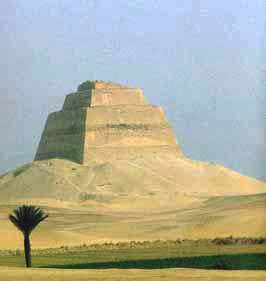 |
He built a pyramid at Meidum close to the northern edge of the Faiyum basin. The identifi-cation of him as the owner has been made indirectly since his name doesn't appear in the monument itself. It is very likely that it was finished by his successor Snofru who was either his son or son-in-law. This pyramid was the first to have straight and smooth sides instead of a number of steps that was the case of the similar monuments from the earlier period.
Some of the casing of lime stones is still in its original place on one side.
The technique also improved and from now on the stones in the masonry were always placed horizontally whether the construction was leaning or not. The general assumption up to recently was that the smooth casing stones put there by Snofru had collapsed a long time ago leaving what is visible today - the inner core in threes steps looking like a broad tower. However all the debris surrounding the building are hardly a part of the original construction and thus brought there later. A guess is that it was a ramp for mining the fine smooth limestone when it was taken away already in ancient times for use in other building projects.
| The complex at Meidum
contains many mastaba tombs north of the pyramid (not shown here). A) The pyramid. B) A small mortuary chapel. C) Ceremonial path from the valley temple (not excavated). D) "Mastaba 17", over 100 m long, and from an unknown owner. E) Pyramid of Huni's queen. |
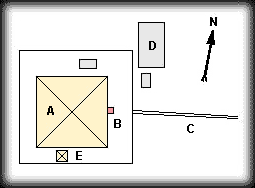 |
The grave chamber does not contain a sarcophagus (today) and there is no trace of a burial, but this does not mean that Huni didn't have his final resting place here.
The geographical location of the pyramid shows a break of tradition, because he moved the royal cemetery 90 kilometers to the south from the Sakkara area. North of the pyramid lots of tombs from his son Snofru's court are placed. Two of them are the largest mastabas in Egypt and one (number 16) measures 60 x 120 meters and is a double tomb of Snofru's son Nefermaat and a high ranked official. Number 17 is situated right by the north-east side of the Huni's pyramid enclosure (marked D in picture above) and is 100 meters long. The owner's name is not known.
The Egyptologist Nabil Swelim suggests that Huni possibly is the builder of a very small and not so well known brick pyramid within a large enclosure at Abu Roash 8 km north of Giza. It is placed in the plain a couple of hundred meters south of the pyramid of Djedefre. Built around a rather large rock formation it has an ascending corridor from the north side and a grave chamber made in a way typical for the early fourth dynasty. Though built of mud bricks (unique for the period if dated correctly) Swelim suggests it might be the work of king Huni.
2575 - 2465 BC (110 years)
Egyptian history with the construction of the great pyramids.
All kings were related (father-son-uncle-cousin-nephew) except the last one.
In a dim period a king (or two) had brief reigns. Bika was probably one of them.
Ratoitis can be Djedefre, and if so misplaced and with a too long reign.
The numbers are from Egyptolgy and the order is Manetho's.
Nothing has jet been found which can identify
his last pharaoh - Thamphthis.
| Name | Manetho | Reign | Manetho | Pyramid | |
| 1 | Snofru | Soris | 24 | 29 | Dashur |
| 2 | Khufu | Sophis I | 23 | 63 | Giza |
| 3 | Djedefre | - | 8 | - | Abu Roash |
| 4 | Khafre | Sophis II | 26 | 66 | Giza |
| 6 | Menkaure | Mykerinos | 18 | 62 | Giza |
| - | Ratoisis | - | 25 | - | |
| 5 | Bikka (Baka) | Bicheris | 4 | 22 | Zawiyet el-Aryan |
| 7 | Shespeskaf | Severkeris | 7 | 7 | Sakkara South |
| - | Thamphitis | - | 9 | - | |
| Total years = | 111 | 243 |

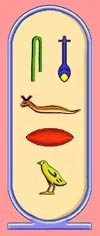 Snofu |
His Horus name Neb Maat "Lord Of The Harmony" is seen within the serek in picture left and his personal namn Snofru within the cartouche to the right.
By marrying one of his half-sisters Hetepheres I, Snofru became the pharaoh over the two countries.
His queen seems to have given him only one surviving child - Khufu, but with two secondary consorts he had: Nefermaat, Rahotep, Ranofer, Kanofer and Ankh-haf plus one whose name is unknown. The first two were buried at Meidum.
His internal policy seems to have been focused on maintaining centralized power and prevent it to spread among high-placed officials and nobilities. He therefore rearranged the land- ownership nation wide, probably to prevent these classes from becoming too powerful.
Snofru completed the big pyramid at Meidum, a monument presumed to have been built by his father Huni (see above).
Then he for some unknown reason, moved the location of the royal burial grounds from the remote southern Meidum to Dashur a trip of 90 km to the north just 10 km south of the old royal cemetery of the capital at Sakkara.
At his newly founded cemetery he erected two huge pyramids.
At the southern, believed to be the oldest, the leaning of the sides were changed from an angle of ~54° to ~43° halfway to the (final) top. The result gave a unique silhouette and it's today called the "Bent Pyramid" that was called "The South Shining Pyramid" (picture below left).
It's unique in having two entrances, from the east and north sides leading to three chambers in which no sarcophagus was found. It's believed that the grave chamber still might be in there skillfully hidden by the architects and awaiting to be found.
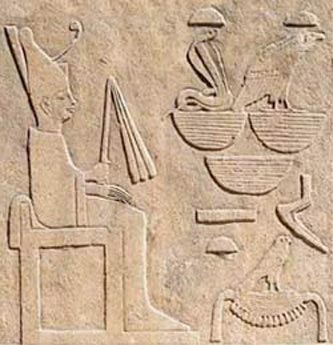
|
Detail (upper part) from a stele found in a small cha- pel by the south side of Snofru's Broken Pyramid
at Dashur.
The pharaoh sits on his throne seemingly content and almost smiling. He is holding a flail in right hand and the left is unusually empty. Upon his head is seen the double crown and in front of him is the cobra and the vulture - the patrons of Lower and Upper Egypt. This carving in high relief (to be seen in the Egyptian Museum in Cairo) is one of few depictions of him. |
The inner design was of similar architectural type in both pyramids - sloping corridors ending with grave chambers and a couple of rooms. Most chambers had corbelled roofs making it look like an inverted pyramid from inside.
The impressive northern pyramid became the first "real" pyramid with straight sides and is also called the "Red Pyramid". Its low angle of ~43° is just like the upper part of its bent neighbor 2 kilometers to the south. It was called "The Shining Pyramid" (picture below left).
Evidence in writing from a stone in the Northern Pyramid tells that it was started on before the other one was finished and thus they were built partly simultaneously.
Snofru was considered to have been a good and wise pharaoh by the after living (his son Khufu was not), and his cult was still going on well into the Middle Kingdom half a millennium after his death.
 Medjedu |
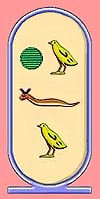 Khufu |
His Horus name within the serek left means: (He who) strikes (i.e. crushes the enemies). Old Greek historians gave him a reign of 50 and 65 years, but these figures are far too high. The Egyptian Royal canon of Turin gives him 23 years and modern Egyptologists estimate his reign to be just about that - a quarter of a century.
He had at least four wives, with whom he had several children. Queen Henutsen gave him the son Khafre (a king to be) and another and probably the oldest son was Djedefre who also was the very next king to take office.
He continued the expansionist policies of his father Snofru by extending the Egyptian borders to the north-east to include Sinai and Upper Egypt maintaining mili-tary presence to protect economic resources like mines. He held economic links with Syria in the north and Nubia in the south.
Khufu built his funerary monument away from his father's and moved from Dashur 40 km northwards to the limestone plateau at Giza. There he erected the Great Pyramid, a monument that has made him one of the most famous kings of the Ancient Egyptian history.
An old misunderstanding is that slaves built the pyramids, but this is not true. The bulk of the working force toiling on the pyramids were common citizens who had nothing to do during the flooding of the Nile when the cultivated land was under water. Recent discoveries (year 2000) from the Giza plateau have shown that they were housed and paid, at least some of them. They were even buried near the pyramid, and could thus be a part of the king's eternal life and cult after death.
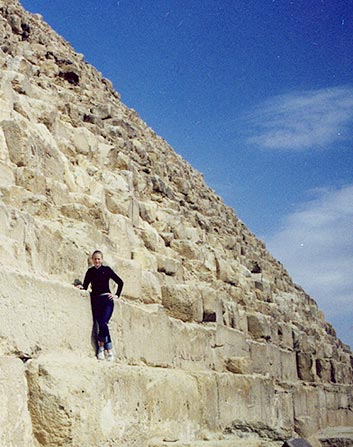
|
The 2,3 million blocks of stone of which the pyra- mid is built are of a huge size and having an
ave- rage weight is about 2,5 tons at the base decrea- sing for every layer going upwards.
The inner core now visible was neatly hewn and no empty space was allowed between the blocks. If the accuracy has the same high standard deeper in- side the construction we don't know, but it's likely. The casing of white smo- oth lime stone has been stripped off long ago to be used for building mosques in Cairo on the other side of the Nile. |
A Middle Kingdom story from the Westcar Papyrus, describes Khufu as a cruel tyrant with no respect for life. Right or wrong we don't know, but a fact is that portraits in any form of Khufu seem to have vanished and only on tiny statuette made of ivory remains, it was found in Abydos in Upper Egypt. This is a strong indication that his memory for some reason was delibe-rately erased after his death.
Like his father before him he had a reign relatively free from threats from outside the country. He took measures to maintain the positions by military force in economically important regions like the Sinai Peninsula for its valuable minerals and Nubia for its treasures of fine stone, preferably red granite used for buildings. His aftermath is dark and he was said to have ignored the gods (!), an accusation that looks like being a political statement by someone trying to strengthen his own position at the moment. Anyhow Khufu has gone to history as the builder of the single most impressive monument of all times.
 Khufu was succeeded by his oldest son Djedefre (his Horus name "Hor-Kheper" seen within a serek in picture right). He married his half sister Hetepheres II,
probably to get a claim to the throne since his mother was one of his father's secondary wives
whose name is not known.
Khufu was succeeded by his oldest son Djedefre (his Horus name "Hor-Kheper" seen within a serek in picture right). He married his half sister Hetepheres II,
probably to get a claim to the throne since his mother was one of his father's secondary wives
whose name is not known.Beside his half sister Djedefre also had other wives, and with one of them, Khentet-en-ka, he had at least three sons, Setka, Baka and Hernet and one daughter, Neferhetepes.
The Turin King-list credits him with a rule of 8 years which is in line with the estimations made by the Egyptologists today.
Little to nothing is known about his political deeds as to trade and security towards Egypt's neighbors in the Mediterranean region to the north and Nubia in the south. He was the first king to use the title "Son of Re" among his others, which is seen as an indication of the growing popularity of the cult of the solar god Re from Heliopolis. This god had occurred in a king's name already in the second dynasty (Nebre/Reneb), and should do so in this new form for 2,500 years to come.
He moved north to build his pyramid to Abu Rawash, some 8 km to the north of Giza, and the reason can be that there was no proper area left at the site. He named his tomb monument "The pyramid is a Sehedu-star" (picture below left) and the tomb was unfinished when he died. Today (2006) it's substructure is open for visitors who can walk down into his grave chamber.
The pyramid area was enclosed by a wall and at the south west corner a smaller satellite pyramid was built, probably for the king's first queen.
The work stopped when about 20 courses were in place, and some casing of granite is still on the spot. What kind of pyramid it was supposed to be was not clear for many years and the reconstructed angle obtained by putting casing blocks in place (in theory) said that it was to be far steeper than the pyramids at Giza. This theory told that he possibly had a step pyramid in mind, or a mastaba, but examinations in the 1990s has given the final answer to the question. A shifting angle of the inner core from one corner (a construction detail of unknown purpose known from other pyramids) has bewildered earlier scholars and today (2002) the original angle is set to around 52 degrees, just like the pyramids at Giza. This makes a height of 67 meters calculated from a base side that was 106 m, which gives a result very similar to the monument of a king to be - Menkaure, who was his nephew.
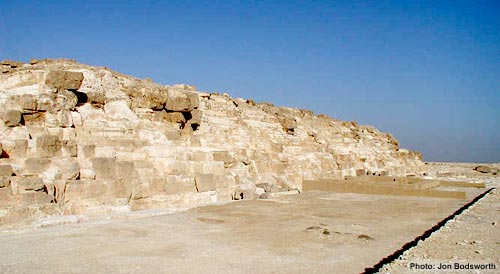
|
After being used as a quarry Djedefre's pyramid is today reduced to a dozen layers of cut stone and nothing of the original casing is left in its original place.
|
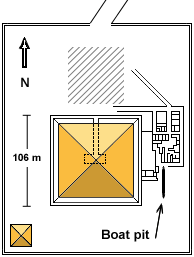
|
A causeway leading down to the Nile, a stretch of 1.700 meters, is going in the direction north-east by the monument due to the topography. It's still intact in some sections and partly hewn out directly from the rock and rising 10-12 meters above the surroundings.
His mortuary temple lay at the east side of the pyramid and was a structure of brick possibly abandoned when the king died, and not meant as a shrine from the looks of it. An open space in the yard to the north (striped in the picture left) might have been the intended place for the permanent structure which possibly never came to be.
South of the temple remains is a pit for a funeral boat cut deep into the bedrock, just like his father had at Giza. It's 35 m long and has a depth of 9,5 m. The breadth is not great: just around 4 m. The question why he moved from Giza has been debated and one theory is that he came closer to Heliopolis on the other side of the Nile. A feud within the family about the succession has also been put forward, but this has not been proved in any way. Looking at his face (if it's a portrait) he has similar looks as his younger brother Khafre who became the next pharaoh.
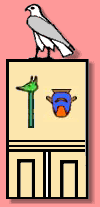 Weserib |
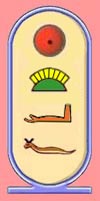 Khafre was the son of king Khufu and queen Henutsen, and followed his elder half-brother as
pharaoh. He was married with his (half?) sister with whom he had the son, Menkaure, the king to
be. At least six more off springs of his are known by name.
Khafre was the son of king Khufu and queen Henutsen, and followed his elder half-brother as
pharaoh. He was married with his (half?) sister with whom he had the son, Menkaure, the king to
be. At least six more off springs of his are known by name.It's not known why he succeeded by his half-brother on the throne, but it is possible that none of his former king's sons had survived and that Khafre thus was the oldest surviving male descendant of their father Khufu.
The Turin canon records a rule for him of more than 20 years and according to Manetho and Herodotos it was 66. (The two Greek historians took out "maximum" of years for most of the pyramid builders to help them to finish their monuments). Today it's generally accepted however, that he ruled for about 26 years, possibly a few more.
In the picture upper left his Horus name is shown within a serek, meaning "Strong of Heart". During his reign the solar-religion grew in importance and like his brother before him he adopted the title "Son of Re", a tradition that lasted for over a millennium.
The interior is much simpler than the structures shown within his father's monument. Down at the Nile he erected an impressive Valley Temple of red granite that's still standing to a great extent. Just outside alongside the ceremonial path up to the pyramid he had cut out the famous Sphinx out of the rock. This gigantic lime stone sculpture is still very well preserved as far as the head is concerned, but the stone layers of the body is of poorer quality and heavily eroded.
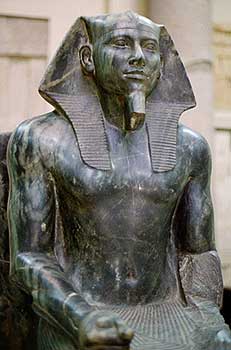
|
This magnificent statue of king Khafre is exposed in the Egyptian Museum in Cairo. The material is the very hard stone diorite and it was found by his great Valley temple where recesses show that lots of statues once were erected of the pharaoh. The king sits on his throne with a slightly dreamy look in his eyes. In his right hand he once had a flail, the symbol of the harvests coming from the soil of the Nile valley. In his left hand was once a herdsman's crook, the symbol of cattle breeding. (photo: Jon Bodsworth gizaview) |
In front of its paws are the remains of a contemporary building called the "Sphinx Temple" where 10 colossus statues of the king once had stood. It was probably never finished and has a court yard similar to that in the Mortuary Temple a bit uphill by the pyramid. The present state of this construction is poorer than his Valley Temple.
Khafre had a reign similar to his father with great prosperity in Egypt and almost no disturb- ance from the outside. The central power was maintained and stability and continuity were factors that were put forward. Despite the seemingly conservative society, progress in all sectors were constantly going on.
An unknown pharaoh with a great unfinished monument
Pharaoh Bikka is a shadowy ruler though he is placed right in the middle of the most famous of all dynasties in Egyptian history - the fourth. His brief reign is the reason to his anonymity among archaeologists but he is named Bakare (like in the cartouche below right) in later king lists by his countrymen, and put between Khafre and Menkaure (see picture below).
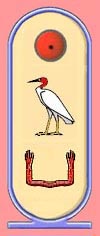 Theories about his kinship to the other kings have put forward suggestions of feud and
rebellion, but his way to office can also be explained in more peaceful and not so dramatic way.
Theories about his kinship to the other kings have put forward suggestions of feud and
rebellion, but his way to office can also be explained in more peaceful and not so dramatic way.If the oldest living male of the family inherited the throne it all fits. Khufu was followed by his son Djedefre succeeded by his brother Khafre who was followed by his nephew (Djedefre's son) Bikka who was a mature man by then. After his death his younger cousin Menkaure (Khafre's son) became the new king in his middle age.
The tricky reading of the hieratic name in the cartouches found at the remains of his pyramid (see the picture below left) has been read as Ba-ka or Bik-ka and thus it fits with the son of Djedefre's - Baka and Manetho has a king in his list by the Greek name Bicheris. Other suggestions are:
Ba-Ka-Rê (Canon of Turin and a tonb at Sakkara), Neb-Ka (Kurt Sethe, J. Cerny) Baef-Rê, Schena-Ka (Kaplony), Nefer-Ka (Maspero) and Hor-Ka (Möller) In any case he has left a remnant that surely has the traditional grandeur and size for a monument from the fourth dynasty.
It is situated at Zawiyet el-Aryan 4 km south of the royal cemetery at Giza and is today called the "Unfinished Pyramid". It was planned to be a pyramid of great size begun by a ruler confident in a long reign ahead of him, but due to the king's premature death all that was made were parts of the foundation and enclosing walls. It was excavated in the first years of the 1900s by the Italian Barsanti and revealed both interesting and confusing finds. To be a very obscure ruler like Bikka an irony is that the sole remnant of his is of such huge proportions. There are still remains from the great enclosure but none from a ceremonial road to the Nile.
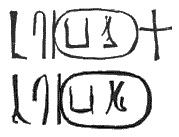
|
The sign BA (the leg)
have made Egyptologists read the name Ba-ka. Reading of second sign within the cartouche is very difficult. |
The parallel to the white alabaster coffin of Sekhemkeht from the third dynasty is striking and a very likely explanation is that this tomb also was robbed already during the disorderly days after the collapse of the Old Kingdom. It was then restored in later times and projects like this were carried out in the New Kingdom when one of the sons of Ramses II was a dedicated restorer of older temples, tombs and artifacts.
An architectural likeness was that it was built exactly like king Djoser's last resting place under his pyramid at Sakkara and the tomb of Djedefre at Abu Roash - a free standing granite grave chamber at the bottom of an open shaft.
 Khau khet |
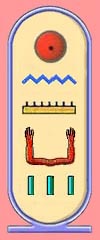 King Menkaure entered office as a mature man after the death of his older cousin Baka.
King Menkaure entered office as a mature man after the death of his older cousin Baka.His Horus name Kau khet (the bull with divine power) is seen within a serek in picture left.
He did not want to repeat his cousin's mistake by starting the work of a big tomb and not live to see it be completed. He thus built a pyramid beside his father's and grandfather's on the Giza plateau and named it: "The Divine Pyramid" (picture below left). Though it was considerably smaller and Menkaure's reign has been estimated to at least 25 years, he was unfortunate not to see the final state of it - he died shortly before.
His tomb is the most technically advanced of the Giza group and its interior is more elaborated and was altered from an original structure of more moderate size.
At the west side his large Mortuary Temple was erected and it was also planned to be cased by granite. Some of it is still in place but the construction was incomplete when his reign terminated, and finished rather hastily by his successor. From here a straight causeway leads down to the Valley Temple of which almost nothing is left today.
In the first decade of the 20th century a group of statues were found in a trench of the temple ruins and they are among the most perfectly made sculptures ever seen in world art. They are today on display in Egypt and the USA and two of them can be seen in the pictures below.
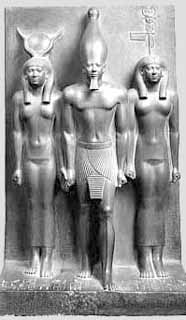
| and his women Menkaure is shown as a healthy well built and rather young man as he poses with the goddess Hathor (left) and a deity guarding a province. It is today in the Egyptian Mu- seum in Cairo. In picture right he is seen with his supposed first queen, but more likely a godess since she is a bit taller. This masterpiece is today to be seen in the Metropolitan Museum of Art in New York, USA. 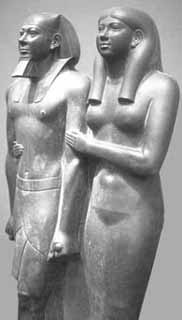
|
Menkaure is the king from the Old Kingdom that Egyptologists have the best knowledge about as far as his physical appearance is concerned. This is due to a lucky strike made by American archaeologist Reisner in 1910 when he found half a dozen undestroyed statues of the king together with goddesses or his queen (see picture above). These depictions have made science able to reconstruct his looks since they seem to be portraits rather than idealistic depictions. The body was made in an athletic way though he was in his middle age when he came into office.
When his days were over the fourth dynasty in reality came to an end. For some reason none of his sons ever reached the throne, and his follower was a man from outside. If this break was due to intrigues within the palace or even a rebellion is not known, but the royal bloodline on the male side was hereby broken.
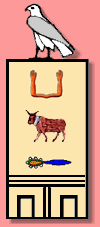 Shepseskhet |
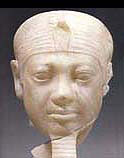 Shepseskaf was probably not of royal stock and if so had to marry in to the royal family to get hold
of the throne. When he came to power there are indi- cations of some disorder in Egypt. His first
years seem to have been quite difficult with confron- tations with various groups of priests and
probably parts of the nobility as well. The most serious was when provinces rebelled against his authority. If the conflict escalated beyond civil
obedience we don't know, but it probably did not. He restored order in the
country and could to some degree complete his predecessor Menkaure's monument at Giza.
Shepseskaf was probably not of royal stock and if so had to marry in to the royal family to get hold
of the throne. When he came to power there are indi- cations of some disorder in Egypt. His first
years seem to have been quite difficult with confron- tations with various groups of priests and
probably parts of the nobility as well. The most serious was when provinces rebelled against his authority. If the conflict escalated beyond civil
obedience we don't know, but it probably did not. He restored order in the
country and could to some degree complete his predecessor Menkaure's monument at Giza.His Horus name meaning "Horus whose Body Is Noble" is seen within a serek in the picture left.
The only depiction possibly to be of him is a head of white alabaster (above right), but its identification is very disputable since it was found in the Valley Temple of Menkaure whose characteristics it seems to have.
Shepseskaf is unique in Egyptian history by making an invention of his own for his grave monument, today called "Mastabat el-Faraún" - Pharaoh's Mastaba.
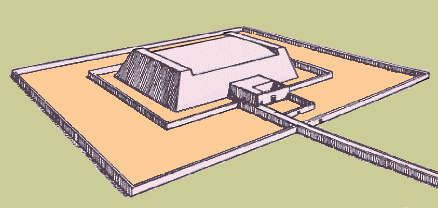 |
An overview of the building shows its great size (100x74x19 m) and it was once cased with white limestone now long since gone. The whole area was enclosed with two stonewalls in a rectangular shape as the monument itself. Much of it has been quarried away a long time ago. The stone blocks in the construction were generally larger than those used in the pyramids at Giza showing that the Egyptians gradually learned to handle block of greater size.
Nothing much is known of his deeds and when his brief reign of about seven years came to an end, it closed the dynasty. Never again should the glory like dynasty four repeat itself and no king should have the means to make similar monuments in the future. When Egypt once again became a mighty power in the Middle East a great deal of the recourses were put outside its borders to maintain this strength. The time of divine ruling and gigantic project made in a religious belief of a living god was ended for good.
2465 - 2323 BC (142 years)
Eight pyramids from nine rulers are known up to now and most of them
are placed at the new royal burial ground at Abusir.
The faith in the country took a new path with the solar cult as dominant.
The real power was slowly going over from the kings
to influential classes in society.
| Name | Manetho | Reign | Manetho | Pyramid | |
| 1 | Userkaf | Ogserkeris | 7 | 28 | Sakkara |
| 2 | Sahure | Sehpris | 12 | 13 | Abusir | 3 | Nefererkare | Neferkeris | 20 | 20 | Abusir |
| 4 | Shepsekare | Sesiris | 7 | 7 | Abusir? |
| 5 | Neferefre | Chaires | 3 | 20 | Abusir |
| 6 | Niuserre | Rathoris | 24 | 44 | Abusir |
| 7 | Menkauhor | Menkeris | 8 | 9 | ? |
| 8 | Djedkare | Tankeris | 32 | 44 | Sakkara South |
| 9 | Unas | Jaunnos | 33 | 33 | Sakkara |
| Years = | 146 | 218 |
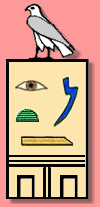 Irimaat |
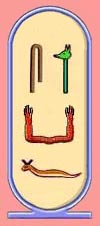 Userkaf |
His Horus name Userkaf (within the serek left) means "Horus, Who Does What Is Right", and his personal nomen Userkaf (within the cartouche right) means "His Ka Is Strong". He moved to the very heart of the Sakkara cemetery for his tomb and had the nerve to erect his tomb monument only fifty meters from the enclosure wall of the mortuary complex of Djoser, then over 200 years old and probably with his cult still in action.
Beside the planning of his tomb, Userkaf began a totally new type of building project at Abusir a couple of kilo- meters to the north, where most of his followers should erect their pyramids. This was something quite unique - a construction of a Sun Temple separated from is tomb.
This cult center of the sun god Re, had a gigantic stone obelisk as the totem, symbolizing the sun. An altar was placed for offerings and the Palermo stone (made later in this dynasty) states that two oxen were sacrificed here every day. This faith had by now grown to a national cult and from now on the king had as one of his titles: "Son of Re".
When this site was excavated in the 1950s it turned out to be in a severe state of ruin since it had been a stone quarry in ancient times.
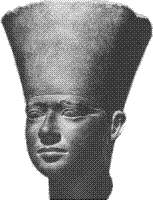 The ground plan and different stages of
construction was able to measure out though, and the conclusion was that more than one pharaoh
had contributed to the building over the years. It is presumed that king Neuserre (100 years
later) added the inner enclosure wall and chambers of limestone.
The ground plan and different stages of
construction was able to measure out though, and the conclusion was that more than one pharaoh
had contributed to the building over the years. It is presumed that king Neuserre (100 years
later) added the inner enclosure wall and chambers of limestone.At the end of the causeway down by the Nile was a Valley Temple, and the whole concept was similar to the pyramids of the pharaohs, with the difference that the tomb was changed for a shrine to the solar god Re. Written sources tell that six sun temples were built during the fifth dynasty, but only four have been found. A black stone head of the king (picture left) was found at the site. Some doubts about if it really is the king have been put forward since he is looking so young considering he became pharaoh as a middle aged man. Nonetheless this is an example of how sculpturing and art in general stood at its peak in Egyptian history at this point. Thereafter a general decline was clearly visible and never again in Egyptian history did it reach the standard of dynasty five.
Userkaf's tomb was built at Sakkara as a pyramid. Its name was "The Pyramid Which is Pure in Places" (picture below left). The temple by the pyramid had a floor made of black basalt stone and so was the foundations of the walls. The rest was made of white limestone from Tura and carved with relief scenes of offerings, decorations of animals etc.
at Sakkara The complex had an unusual solution with the Mortuary Temple and two small satellite pyramids at the south side, (perhaps due to a weak bedrock). The pyramid once was | 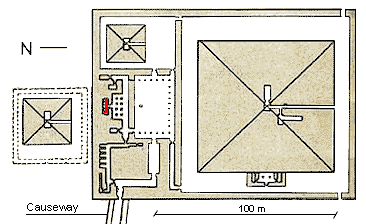
|
The effort taken on the inner construction was high and huge blocks were used with great precision for the grave chambers throughout the dynasty. When the fine casing blocks were taken away many years later, parts of the core collapsed leaving all the Abusir pyramids in a state of ruin.
The causeway entered the enclosure wall at the southeast corner, but today nothing is left of it. Its destination by the Nile - the Valley Temple, is also yet to be found.
Userkaf was a great inventor with his sun temple and great obelisk that became standard for the rest of the dynasty. This has given him a special position in the Egyptian history though his reign was only about seven years.
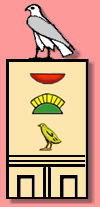 Nebkhau |
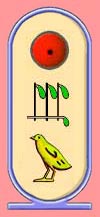 Sahure |
His name (within the cartouche right) means "He who is close to Re". When the remains of his tomb was exca- vated in the first years of the 1900s a great amount of fine reliefs were found to an extent and quality superior to those from the dynasty before. Some of the low relief-cuttings in red granite are masterpieces of its kind and still in place at the site. Among the scenes we see boats coming with big trees, probably cedars from Lebanon where his name has been found. The crew was mixed with also Asians sailors onboard.
His dozen of years in office seem to have been concen- trating upon peaceful trade rather than military actions, though a raid into Libya capturing livestock is recorded. He worked the turquoise quarries in the Sinai as well as mining diorite in the southern Nubia. And some of these events do occur on the Palermo stone made half a century after his death.
Inscription tell that he built a sun temple named Sekhet-Re, "the Field of Re", as well as a palace, called Uetjesneferusahure "Sahure's splendor goes up to heaven" but these monum- ents are still to be found. His pyramid complex on the other hand shows a decline in both size and quality as were the rest of the pyramids from this dynasty. They had an inner core of roughly hewn stones in a step construction held together in many sections with mortar of mud.
 Ruler for stability and life: Sahure |
His Horus name Nebkhau (within the serek in picture upper left) means "Horus, The Lord Of Apparitions", and his own personal nomen Sahure (within the cartouche in picture upper right) means "He Who is Close to Re".
Few depictions of the king are known, but in a sculpture he is shown sitting on his throne with a local nome (province) deity by his side.
Today only the inner construction remains partly visible in a pile of rubble originating from the crude filling of debris and mortar behind the casing stones taken away a thousand years ago. The whole inner construction is badly damaged and not possible to access today (year 2002).
The entrance at the north side is a short descending corridor lined with red granite followed by a passageway ending at the burial chamber. It has a gabled roof made of big limestone layers and fragments of the sarcophagus were found here when it was entered in the early 1800s.

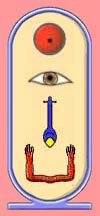 Nefererkare Kakai was probably the son of Userkaf, the first king of the 5th Dynasty and thus younger (half-?) brother to his predecessor king Sahure. His Horus name Weserchau (The Force That Has Appeared) is seen with- in a serek left.
Nefererkare Kakai was probably the son of Userkaf, the first king of the 5th Dynasty and thus younger (half-?) brother to his predecessor king Sahure. His Horus name Weserchau (The Force That Has Appeared) is seen with- in a serek left. He was the first king to employ both a prenomen and nomen (he had two names and two cartouches), a cus- tom that later kings would follow. In the picture right is shown one of thhem - Nefererkere, meaning "Beautiful is the Soul of Re".
His pyramid complex at Abusir was unfinished during his lifetime, but obviously finished by his successors.
About fifteen years after his death king Neuserre incorp-orated both his valley temple and causeway into his own complex (as seen in view over Abusir). Somewhere in the vicinity he built a solar temple, because the written historical texts say so, but nothing of this shrine has so far been found and still waits to be dug out from the sand.
Egyptologists do not agree on the length of his reign and figures between fourteen and twenty-four years have been suggested. Nefererkara is notable for an innovation in the long row of royal names (titles). He was the first ruler to give himself two names within a cartouche - one as the son of Re and one as his personal name. All his followers in Egyptian history took up this custom. At his pyramid complex hundreds of fragments of papyrus were found in the late 1800s and the writing was in a new "shorthand" type of hieroglyphs, the so-called hieratic type of signs used for practical reasons rather than decorative.
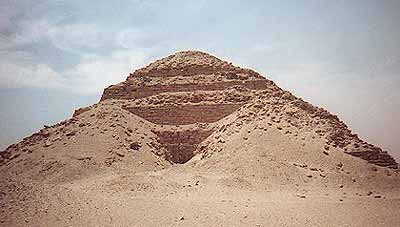 |
Today four of the original six steps of the core are visible in Nefererkare's pyramid when the casing stones are gone. The design was later altered and the sides were made straight.
|
This first example of this sort of text surely had a long time of development and is this king's most notable contribution to Egyptology. When decrypted and published in the 1960s it turned out to be parts of the royal archive at the site. It contained details of the administration for guarding the temples, taking care of the daily offerings like bread, beer, meat, fowl, corn and fruit. It also showed tables for regular inspections and records of the equipment in the cult of the dead pharaohs.
The name of his pyramid was:
Documenting the deeds of king Neferirkara Kakai is tricky, and one of his officials named Ty is more known about. Thus we do not know anything about his political affairs within the country and abroad, nor do we know how he held the borders against nomad tribes. He is likely to have followed the "scheme" made by his predecessors, and the general impression is that his reign was a peaceful period.
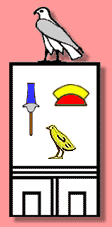 Little to nothing is known about king Shepseskare apart from his name. Almost all Egyptologists agree on that he ruled for a short period between Neferirkare and Neferefre, but a few think he ruled after these two.
Little to nothing is known about king Shepseskare apart from his name. Almost all Egyptologists agree on that he ruled for a short period between Neferirkare and Neferefre, but a few think he ruled after these two. His kinship (if any) to the other kings of the 5th Dynasty is not known. The Royal Canon of Turin and Manetho (who calls him Sesiris) notes him for a reign of seven years, and this seems to be a plausible figure.
In the Abydos list he is omitted but his name is present in the Sakkara list.
His Horus-name within a serek (seen in picture right) is "Sekhemkhau" meaning "The Power Has Appeared" where the club stand for power and the rising sun for appearance. This was found in the mortuary temple of king Neferefre.
Very few remains from his time have been found at Abusir. It's seal impressions dated to his reign and these are almost the only contem- porary finds from his brief time on the throne so far (2004).
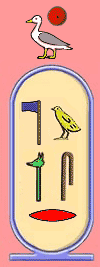 There is a large remnant at Abusir that probably is from him though - what is left of a big pyramid. It is situated north of the complex of Sahure and was found as late as in the 1980s. The work on the monument was hardly begun before it was stopped and consists only of earthwork. The area had been leveled and a foundation was made for the lowest part of the construction - the burial chamber. It's possible that the pyramid was intended to be the biggest of all at Abusir, with a base side measuring just over 100 meters, similar in length to king Nefererkere's pyramid.
There is a large remnant at Abusir that probably is from him though - what is left of a big pyramid. It is situated north of the complex of Sahure and was found as late as in the 1980s. The work on the monument was hardly begun before it was stopped and consists only of earthwork. The area had been leveled and a foundation was made for the lowest part of the construction - the burial chamber. It's possible that the pyramid was intended to be the biggest of all at Abusir, with a base side measuring just over 100 meters, similar in length to king Nefererkere's pyramid. His title (nomen) in his roll as "Son of Re" is seen within the cartouche left. The duck is a homonym for the word "son" and the sun disc symbolizes his "father" - the solar god Re.
His name is put together of the components: flag on a pole (or axe), quail, staff, folded cloth and a mouth and maybe it makes "Netjer-weserw".
Since the kings of dynasty five were completing the buildings of their predecessors (if they were almost finished) it's likely that Shepseskare just had started on his own monuments when he passed away and sailed to "the land in the west". The planned size of his pyramid indicates that he wasn't an old man when he reached office hoping for a long reign, but obviously he had not.
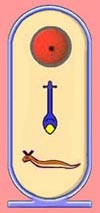 Other statuettes (made in a crude more nonportray- ing form) were also found as well as glazed ceramics making the king's name.
Other statuettes (made in a crude more nonportray- ing form) were also found as well as glazed ceramics making the king's name.After the excavation of the mortuary temple the archaeologists turned to the pyramid itself and the central construction with the burial chamber. It had been robbed already at the collapse of the Old Kingdom but was not totally empty of finds. A lot of interesting objects were found and frag-ments of pharaoh's red granite sarcophagus came to light plus pieces of mummy wrappings and bones, and parts of canopy jars. This indicated that the king (or at least someone) once had been buried here sometime in history. Huge portcullises (stoppers) of granite was intended to block the corridor leading to the grave chamber, but everything was found as it once had been abandoned - in an unfinished state.
The mummy material was examined and probably was from a young man in his early twenties, which fits well to what has been known of the king. Only the first step of a pyramid was completed and it was covered by pebbles and mud mortar on the surface before the dead king was installed in the funerary apartments. He would have rested in his sarcophagus for about 300 years before chaos broke out in Egypt and many royal tombs were ransacked for their goods.
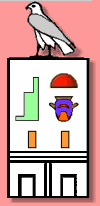 King Neuserre was the sixth king of the 5th Dynasty. His name had the meaning "Possessed by the Power of Re" (picture below left). His Horus name was probably pronounced Setibtawy (seen within a serek in picture right). It's not known exactly how long he ruled Egypt because the Turin Canon is damaged at this very place, but an asumption for around 24 years is general among scholars. Manetho's 44 years looks far too long. There are indications of a more than 30-year reign from his solar temple at Abu Gurab (northern Abusir) where a Sed-fetival is mentioned.
King Neuserre was the sixth king of the 5th Dynasty. His name had the meaning "Possessed by the Power of Re" (picture below left). His Horus name was probably pronounced Setibtawy (seen within a serek in picture right). It's not known exactly how long he ruled Egypt because the Turin Canon is damaged at this very place, but an asumption for around 24 years is general among scholars. Manetho's 44 years looks far too long. There are indications of a more than 30-year reign from his solar temple at Abu Gurab (northern Abusir) where a Sed-fetival is mentioned. Egyptologists have figures between 11 and 31 years. A fragment from a statue in his valley temple states that his first queen had the name Reput-Nebu. Though written remains are scarce we have reason to believe that he was active in all the fields as the other kings from this period. That is - mining in the Sinai, making military campaigns against Libyans and Nubians, trading with Punt for malachite, myrrh, spices etc.
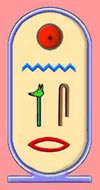
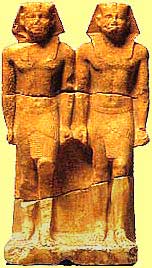
|
| of king Neuserre |
The last expedition of trade to the area around the southern part of the Red Sea is attested for and remains with his name have also been found in Byblos in Syria as well on the island of Elefantine in Aswan at the southern border of the country facing Nubia.
Neuserre built his pyramid complex at Abusir and added a great solar temple 1.500 meters to the north at a place today called Abu Gurab. The construction was totally made of stone and was a masterpiece in Egyptian architecture. In front of a huge obelisk a big altar stone was placed for offerings and it's still in place today after almost 4.500 years.
Fine reliefs were made showing the solar god Re creating the world and being venerated by his son - the king. This was the time in Egyptian history when the cult of Re was at its peak. All kinds of craftsmanship reached its climax at this point of Egyptian history, never to be achieved again.
The picture above left shows the king's throne name within a cartouche - Izi, a short name like some others kings of the time picked for practical reasons.
His pyramid also had a name and in hieroglyphic writing it looks like:
"The Pyramid which is Established of Places" and the three green objects are thrones.
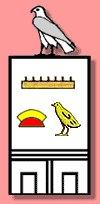 Menkhawu |
A priest from Menkauhor's funerary cult who lived in the 12th dynasty has been found interred in this pyramid, but the significance of this in not clear.
This monument has been examined many times during the 20th century with diverted conclutions from the archaeologists about its age and owner.
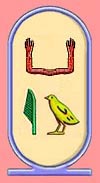 Kaiu |
Similarities to the pyramid of Teti do exist both in the building and the surrounding structures. Observations also seem to connect the Teti complex with the cult of Menkauhor and a final solution to the question who the owner is, may come from an investigation which started in the early months of 2008.
The entrance corridor descends from the north side and is not on a north-south axis. Two granite portcullises were used as stoppers and were found in "locked" position, indicating that a burial once had occurred. The path leads to an antechamber and then to the burial chamber in which a broken lid of a sarcophagus was found.
No pyramid texts were discovered and this can point to a period prior to king Unas (who came into office a couple of decades later) and was the first to make such texts at the very end of dynasty five.
In the cartouche above left we can read Menkauhor's short prenomen Kaiu and the name of his pyramid is known from hieroglyphic text with the meaning (in the picture below) "Divine are the (cult) places of king Menkauhor" and the pharaoh himself is sitting in front of his tomb.
 |
Though we today consider Menkauhor a minor and insignificant pharaoh the Ancient Egyptians might have thought otherwise because his memory cult was still going on in the New Kingdom at least 800 years after his death. He was probably a man in his middle age when he died and he obviously left no son to take his place as the ruler of Egypt.

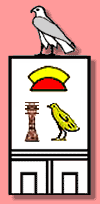 Djedkare, was the eighth ruler of dynasty five and there are no signs that make him a relative of any kind to his predecessor Menkauhor.
Djedkare, was the eighth ruler of dynasty five and there are no signs that make him a relative of any kind to his predecessor Menkauhor. His Horus-name Djedkhawu (meaning "Horus Firm Of Apparitions") is shown in picture right and the prenom- en Isesi (written with the hieroglyphs I-S-S-I) to the left. He had a son and heir named Remkuy who unfortuna- tely died before him. Though he had a long reign of about 30 years, surprisingly few facts about him has come forward. Like the pharaoh before him he probably did not build a sun temple and chose his tomb to be placed in the traditional royal burial ground in Sakkara.
Two expeditions are recorded going to Sinai and one expedition to the mystical country Punt is also noted for in graffiti. He kept both the commercial and diplomatic contacts with the important trade centres in Syria. A few officials from his time are known and he is mentioned in contemporary letters as well as royal ones from the next dynasty. The papyri records found in the funerary temple of the older king Neferirkare are dated to his time.
Djedkare's pyramid is situated at South Sakkara and today it's called "The Sentinel Pyramid". A mummy found within it is believed to be Djedkare himself, and estimated to be from a man about fifty years old, which corresponds well to scientific calculations.
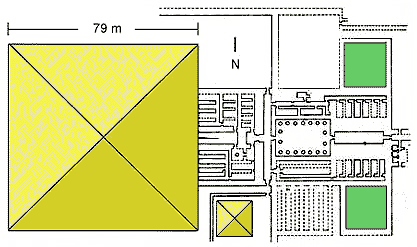 |
Djedkare's pyramid complex had two big massive pylons at the entrance (green). The valley temple still awaits a real investigation. At upper right corner (outside picture) was the Oueen's pyramid. |
After several more or less professional diggings over the years the pyramid was examined in the 1980s and found very damaged and difficult to excavate. The valley temple has had just a few brief investigations and some remains of walls with reliefs from the causeway have been found. At the Nile side the topography is a heavy slope and great efforts have been taken to make the foundation to the mortuary temple. Flanking the entrance were two square massive, tower-like pylons. The entrance hall had very massive walls, perhaps to support a vaulted roof. The entrance was once paved in alabaster all the way into the temple courtyard.
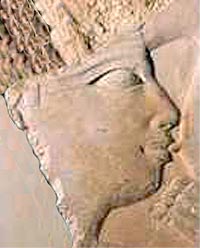 One of few depictions of Unas when he is breast fed by goddess Isis. |
 King Unas is in many ways a shadowy ruler in Egyptian history. His Horus name (picture right) was Wadj-tawy, meaning: "Horus, the flourishing one of the Two Lands". Science has not obtained much of the activities during his long reign and his death seems to have started some sort of confusion and instability at the tran- sition into the next dynasty. This might be due to an estimation that he left no heir to take over his throne, but his two first queens are known by name - Khenut and Nebit. The knowledge about Unas comes to a great extant from his pyramid at Sakkara, which he built just outside the south enclosure wall of Djoser's pyramid complex. It is the smallest but most technically advanced of all from the Old Kingdom. Its grave chamber is decorated with religious spells cut into the walls, the so-called Pyramid Texts, and it was the first royal tomb to contain such hieroglyphic writing.
King Unas is in many ways a shadowy ruler in Egyptian history. His Horus name (picture right) was Wadj-tawy, meaning: "Horus, the flourishing one of the Two Lands". Science has not obtained much of the activities during his long reign and his death seems to have started some sort of confusion and instability at the tran- sition into the next dynasty. This might be due to an estimation that he left no heir to take over his throne, but his two first queens are known by name - Khenut and Nebit. The knowledge about Unas comes to a great extant from his pyramid at Sakkara, which he built just outside the south enclosure wall of Djoser's pyramid complex. It is the smallest but most technically advanced of all from the Old Kingdom. Its grave chamber is decorated with religious spells cut into the walls, the so-called Pyramid Texts, and it was the first royal tomb to contain such hieroglyphic writing.From the well preserved causeway down to his valley temples reliefs have been found from the walls of this once roofed pathway. Boats are coming with granite columns from the south quarries, people working in markets places, nomad hunters at the edge of the desert etc.
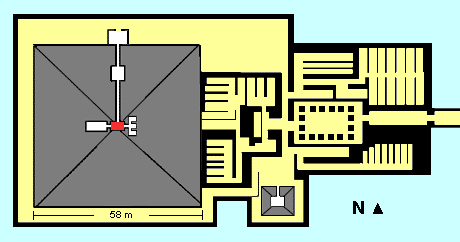 |
building was the smallest of those from the fifth dynasty, 43 m high. |
Some reliefs show the effect of famine with poor people looking like skin and bone. Asiatic traders are seen arriving in Egypt by boat and nomad living at desert edge is illustrated by naturalistic hunting scenes.
Unas probably maintained Egypt's policy of diplomatic contacts with both Syria in the north and Nubia beyond the southern border. Findings at the island of Elephantine at Aswan show exotic animals apparently brought to Egypt during his reign.
Parts of what is believed to be Unas' mummy was found in the late 1800s and are now pre- served and stored in the Egyptian museum in Cairo.
the Old Kingdom ended and was followed by a period of decline.
Dynasties 6-11
-->